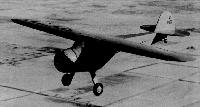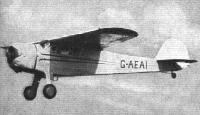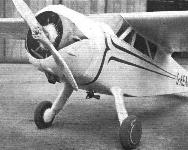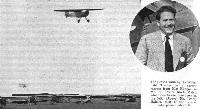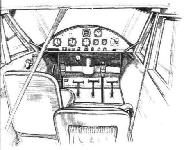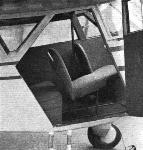
Cessna Model С (UC-77B/D) и Model С Airmaster (UC-94)
Первым продуктом компании "Cessna" после того, как она была вновь открыта в Уичите, штат Канзас, стал самолет Model C-34 - свободнонесущий высокоплан, построенный с использованием последних достижений в области аэродинамики и конструкционных материалов. Первый полет он совершил в июне 1935 года.
Model C-34 имел смешанную конструкцию (дерево и металл), с дюралевой обшивкой в носовой части фюзеляжа, фанерной обшивкой несущих поверхностей и полотняной обшивкой в остальных местах. По желанию заказчика мог устанавливаться не деревянный, а металлический воздушный винт, а вместо стандартного шасси - поплавковое марки "Edo".
Были построены 42 самолета, два из них в годы Второй мировой войны под обозначением UC-77B поступили в эксплуатацию авиации Армии США.
В 1937 году появилась модификация Model C-37, отличавшаяся более широкой кабиной. Были построены 46 таких самолетов, один в 1942 году поступил на вооружение под обозначением UC-77C.
Год спустя появился самолет Model C-38 Airmaster, имевший незначительные изменения в конструкции - фактически, то оборудование, которое ранее ставилось по желанию заказчика, теперь стало стандартным. Машина имела более широкую базу шасси и большой подфюзеляжный щиток, игравший роль воздушного тормоза для снижения скорости при посадке. Были собраны только 16 самолетов C-38.
Последними четырехместными моделями семейства Cessna стали C-145 и C-165 Airmaster. Выкатка нового самолета, получившего тогда обозначение Model C-39, состоялась 11 сентября 1938 года, но вскоре его переименовали в Model C-145 - числовой код теперь отображал не год запуска в серию, а мощность силовой установки. C-145 оснащался звездообразным двигателем Super Scarab мощностью 145 л.с., а последовавшие за ним Model C-165 и Model C-165D отличались только мощностью силовой установки - на них ставился один двигатель Super Scarab мощностью 165 или 175 л. с. соответственно. В 1941 году выпуск самолетов серии Airmaster был прекращен, всего были проданы 42 самолета C-145, 34 C-165 и три C-165D. В 1942 году три самолета Model C-165 были приняты на вооружение ВВС США под обозначением UC-94.
ТАКТИКО-ТЕХНИЧЕСКИЕ ХАРАКТЕРИСТИКИ
Cessna Model C-38 Airmaster
Тип: четырехместный туристический самолет
Силовая установка: один звездообразный двигатель Warner Super Scarab Series 50 мощностью 145 л. с. (108 кВт)
Летные характеристики: максимальная скорость на уровне моря 261 км/ч; крейсерская скорость на высоте 2500 м - 241 км/ч; начальная скороподъемность 244 м/мин; практический потолок 5485 м; дальность 885 км
Масса: пустого 621 кг; максимальная взлетная 1066 кг
Размеры: размах крыла 10,41 м; длина 7,52 м; высота 2,13 м; площадь крыла 16,81 м2
Описание:
- Cessna Model С (UC-77B/D) и Model С Airmaster (UC-94)
- Flight, April 1936
MODERN LIGHT AIRCRAFT REVIEW - Flight, April 1936
PERFORMANCE from AMERICA
Фотографии
-
Aeroplane Monthly 1991-10 / M.O'Leary - Santa Monica auction
Регистрационный номер: NC18599 Glowing Cessna Airmaster NC18599 was a late addition to the auction line up.
-
Мировая Авиация 86
Регистрационный номер: NC17070 Четырехместный Model C-34 оснащался 145-сильным звездообразным двигателем Super Scarab, работавшим на двухлопастный воздушный винт.
-
Jane's All the World Aircraft 1980 / Encyclopedia of Aviation - Aircraft A-Z - v2
Регистрационный номер: NC15462 Cessna C-34.
-
Jane's All the World Aircraft 1938 / 03 - All the world's aeroplanes
The Cessna "Airmaster" Four-seat Cabin Monoplane (145 h.p. Warner "Super-Scarab" engine).
-
Jane's All the World Aircraft 1980 / Encyclopedia of Aviation - Aircraft A-Z - v2
Cessna C-165 Airmaster
-
Flight 1939-06 / Flight
Twenty-three men load the wing of a 1939 Cessna Airmaster to 4,000 lb. The wing normally supports a gross load of 2,350 lb.
-
Aeroplane Monthly 1985-10 / Grapevine
Регистрационный номер: NC19495 Cessna C-145 Air master NC19495, built at Wichita in 1939, is the only airworthy example in Europe. It is seen at Hamble in July 1985 shortly after restoration had been completed by the Antique Aeroplane Company for American owner Paul Skogstad. The Warner Scarab-powered Air master left Hamble for Germany, where it will be based, in late August.
-
Flight 1939-04 / Flight
OVER SAN FRANCISCO BAY: One of the 1939 four-seater Cessnas actually the company’s photographic machine - with a typically Californian crystal-clear background. The new Cessna carries a useful load of 1,000 lb. with a gross weight of only 2,350 lb., and has a top speed of 162 m.p.h.; it is fitted with a Warner Scarab engine of 145 h.p. The agents in this country are Aviation Corporates.
-
Flight 1937-03 / Flight
Регистрационный номер: G-AEAI [5] The American private-owner type: The Cessna.
-
Flight 1936-04 / Flight
Регистрационный номер: G-AEAI [5] The clean lines of the Cessna are admirably shown in this flying picture taken near Croydon.
-
Air-Britain Archive 1987-01
Регистрационный номер: G-AEAI [5] Cessna Airmaster G-AEAI also in 1936. It survived impressment but was burnt out at Blackpool in 1950.
-
Flight 1936-04 / Flight
Регистрационный номер: G-AEAI [5] Fully cowled and pressure-baffled, the installation of the Warner Super-Scarab is extremely interesting. Note the streamline tyres.
-
Air-Britain Archive 1986-02
Регистрационный номер: G-AFBY Cessna C.34 G-AFBY at Staverton in 1947. One of only two registered in Britain, both of which were operated by Murray Chown's Gloucester Aviation Services post-war, this was finished in metallic blue.
-
Flight 1936-09 / Flight
The Cessna winning the Wakefield Trophy by a narrow margin from Miss Klingan, in Mr. du Port's Moth Major, which can be seen low down on the left. (Inset) Mr. Jimmy Haizlip, pilot of the Cessna, looks pleased about it.
Другие самолёты на фотографии: De Havilland Moth Major / D.H.60GIII - Великобритания - 1932
-
Flight 1939-01 / Flight
CENTRAL SKYPORT: A Cessna on the sloping turntable at one of New York’s seaplane bases.
-
Flight 1938-05 / Flight
CENTRAL ENOUGH: A Cessna seaplane on the ramp at one of New York’s “Skyports.”
-
Flight 1936-04 / Flight
In this interior view the standard equipment is shown. The small window on the left can be opened.
-
Flight 1936-04 / Flight
To be examined in conjunction with the interior sketch, this picture shows how the offside seat is slid back for entry to the pilots' seats.
-
Flight 1936-04 / Flight
The self-centring tail wheel (left) is sprung and damped. On the right is one of the cantilever undercarriage legs with the fairing cut away to show the means used to prevent the lower portion of the leg from turning in relation to the main body.
- Фотографии

